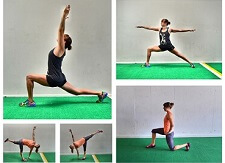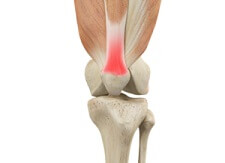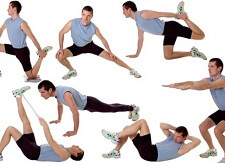- Home
- Common Knee Injuries
- Ruptured Quads
Quadriceps Tendon Rupture
Written By: Chloe Wilson, BSc(Hons) Physiotherapy
Reviewed by: KPE Medical Review Board
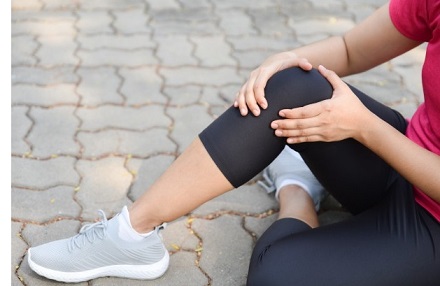
A quadriceps tendon rupture is a rare but serious knee injury.
With a quads tendon tear, the tendon that connects the quadriceps muscles at the front of the thigh to the kneecap (patella) tears
There may be a partial or full thickness tear of the quads tendon, which can severely affect your ability to straighten the leg, walk or climb stairs.
With a complete quadriceps tendon rupture, surgery is advised within the first 4 days to prevent further complications.
Here we look at the common causes, symptoms, diagnosis and treatment options for partial quads tears and complete quadriceps tendon ruptures.
Quadriceps Anatomy
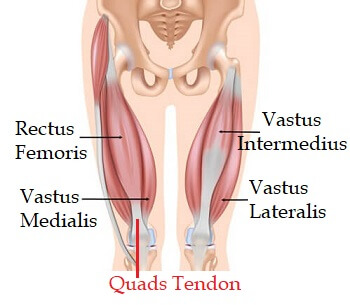
The four quadriceps muscles, rectus femoris, vastus medialis, vastus intermedius and vastus lateralis, run down the front of the thigh and join together to form the quadriceps tendon.
Tendons are strong structures but they are not particularly flexible so if they are suddenly overstretch or overloaded, they can tear.
The quads tendon is a thick, tough band of fibrous connective tissue that surrounds the kneecap and connects the quads muscles to the top of the patella.
Below this, the patellar tendon connects the patella to the front of the tibia, shin bone.
The quads muscles, quadriceps tendon, patella and patellar tendon make up what is known as the “extensor mechanism” of the knee.
The quads tendon plays a crucial role in straightening the knee and stabilizing the leg during walking, running, and climbing stairs.
What Causes A Quadriceps Tendon Rupture?
A quadriceps tendon rupture is a rare knee injury typically caused by:
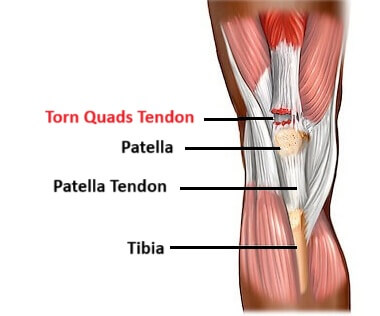
- Sports Injuries: a strong, sudden quads contraction typically when the foot is fixed to the ground and the knee slightly bent e.g. landing badly from a jump or suddenly changing direction
- Fall: Landing with the force going through the front of the knee
- Tendon Weakness: Underlying tendon inflammation and damage from quadriceps tendonitis
- Underlying Medical Conditions: some conditions are linked with decreased tendon strength e.g. diabetes, rheumatoid arthritis, chronic renal failure, hyperparathyroidism, gout and connective tissue disorders
- Corticosteroids: Regular use of corticosteroids can decrease tendon and muscle strength
- Injections: knee injections temporarily weaken tendons making them more prone to tearing
There are two types of quadriceps tendon tears:
- Partial Quadriceps Tear: When some of the fibres are torn but the tendon remains intact – think of it like a fraying rope
- Ruptured Quadriceps Tendon: when the tendon tears completely so it is no longer anchored to the patella
If the quadriceps tendon ruptures, it disrupts the extensor mechanism making it impossible for the knee to straighten independently.
Quadriceps tendon ruptures most commonly affect:
- People over the age of 40
- Men more than women in a ratio of around 8:1
- The non-dominant leg
Symptoms of Torn Quad Tendon
Typical symptoms of a torn quadriceps tendon are:
- Pain: Sudden, immediate pain above the kneecap
- Audible Noise: Popping or tearing sensation at the time of injury
- Limited Knee Extension: Partial tear – inability to straighten knee against resistance. Complete rupture – unable to straighten the knee at all without help
- Difficulty with SLR: With a complete quadriceps tendon rupture it is impossible to lift the leg up straight without the knee bending. With a partial tear, a straight leg raise may be possible
- Difficulty Walking: Walking is often difficult following a quads tendon tear and may be impossible following a complete rupture with the knee giving way or buckling. People tend to walk with a stiff knee and usually struggle to get up and down stairs
- Swelling: Above and around the front of the knee which may be accompanied by bruising
- Cramping: in the quadriceps muscles
- Palpable Defect: Unless the swelling is severe, you may be able to feel or see a gap above the kneecap where the tear is
Diagnosing Quadriceps Tears
Doctors can often diagnose quadriceps tendon tears from your history and a physical examination. They will ask questions about how your injury occurred and what symptoms you are experiencing.
They will also want to know if you had any symptoms prior to the injury to evaluate the likelihood of an underlying quads tendinopathy.
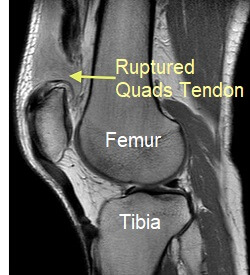
They will then look at the strength and movement in your leg including whether you can straighten your knee against resistance, perform a straight leg raise (SLR) without the knee sagging/bending and perform a squat.
They will also palpate the knee and surrounding area to see if they can feel a gap in the tendon.
You doctor may send you for x-rays, ultrasound or an MRI scan if there is any uncertainty about the injury, or to confirm whether there is a partial or full quadriceps tendon rupture.
#CommissionsEarned from Amazon on qualifying purchases
Non-Surgical Treatment
Non-surgical treatment is indicated if there is a partial quad tendon tear, or for patients who would not tolerate surgery. Treatment typically involves:
- Immobilisation: A knee brace or immobiliser may be work for 3-6 weeks. This holds the knee straight allowing the tendon to heal correctly, preventing it from being overstretched
- Crutches: You may need to use crutches to help you get around for the first few weeks, especially if you are wearing a knee immobiliser. Your doctor may limit how much weight you can put through the leg initially
- Regular Ice: Helps to reduce pain and swelling when used correctly – see the ice treatment section
- Medication: Your doctor may advise non-steroidal anti-inflammatories such as ibuprofen to reduce knee pain and swelling
- Physical Therapy: Your physio will work on a progressive rehab programme of knee exercises to help you regain the strength and mobility in the knee. As your straight leg raise improves they will also wean you off the knee immobilizer/brace appropriately.
People usually make a good recovery from a small, partial quads tear without needing surgery and your doctor or physical therapist will be able to advise you on when you can return to sports/activities, which usually takes around 4-6 months.
Surgical Treatment
With a complete quadriceps tendon rupture, knee surgery is almost always necessary, particularly when there is loss of the extensor mechanism. Surgery may also be advised for large partial quads tendon tears, or if there is underlying degeneration from quadriceps tendinosis.
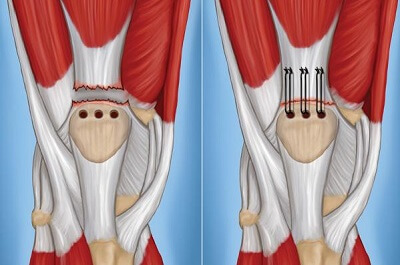
The most common surgical technique is to drill holes into the kneecap.
Sutures, aka stitches, are placed through the tendon and then looped through the drill holes.
The surgeon pulls the sutures to the correct tension to reattach the quads tendon to the patella and ensure that the kneecap is in the correct position.
More recently, a new type of surgery has become popular where rather than drilling holes into the kneecap, suture anchors (small metal implants) are used instead.
There is so far insufficient research to say which method works best, but it is thought that using suture anchors decreases gap formation and increases tendon strength.
The sooner knee surgery is carried out following a ruptured quads tendon, the better the outcome. This is because the damaged tendon will quickly tighten and develop scar tissue leading to shortening of the tendon.
Ideally, surgery should be performed within 48-72 hours of the quadriceps tendon rupture. Ruptures more than 2 weeks old can retract by around 5cm, making surgery more challenging, and potentially limiting functional recovery.
If knee surgery has been delayed and the quads tendon has significantly shortened, then a graft is inserted to bridge the gap and lengthen the tendon.
Recovering From Surgery
Following surgery for a quadriceps tendon rupture, the knee is normally immobilized in full knee extension using a brace or knee immobiliser splint and crutches for 4-6 weeks. This allows the tendon to heal in the correct position and reduces the risk of re-injury. The surgeon may also limit how much weight you can put through your leg initially.
Physical Therapy will be necessary to work on the correct blend of progressive strengthening and flexibility exercises. Initially, you will concentrate on isometric strengthening exercise to strengthen the knee without moving it.
As things progress, your doctor or physical therapist will start to unlock your knee brace to allow a small, controlled amount of movement in the knee when weight-bearing without overstressing the quads tendon. After around 4-6 weeks, you should be able to stop wearing the brace altogether and can instead focus on knee exercises to regain mobility and flexibility.
Some surgeons advocate the use of early joint mobilization in an attempt to reduce knee stiffness and muscle wasting. There is conflicting evidence over which method is best but there is definite agreement that the sooner surgery is carried out for a quadriceps tendon rupture, the better the recovery.
Returning to Activities
It usually takes around 4-6 months to recover from surgery for a quadriceps tendon rupture, and in some cases it can take up to one year to return to your usual activities.
Before returning to sports or strenuous activities you should:
- Have minimal or no pain
- Have regained full or near-full range of motion in the knee
- Have regained at least 85% strength in comparison to your uninjured knee
- Be able to perform functional activities such as hopping
- Have regained normal balance and proprioception
- Completed your physical therapy course including sport-specific training
If you has a partial quads tear rather than a complete rupture, it usually takes 6-12 weeks to regain full function.
Possible Complications
The most common complications following a quadriceps tendon rupture are:
- Ongoing Pain: in the thigh and around the kneecap
- Decreased Strength: in the quads muscles, particularly noticeable during prolonged standing, going up and down stairs and when squatting
- Knee Stiffness: full range of motion at the knee may not be regained
- Reduced Function: you may not get back fully to your pre-injury level
Outcomes have been shown to be more favourable with early surgical intervention after a torn quads tendon with most people returning to full function with a year.
Summary
- A quadriceps tendon rupture is one of the least common knee injuries
- It is often associated with underlying tendon weakness and degeneration from quadriceps tendinosis
- Sudden overstretching or overloading of the tendon causes it to partially or fully tear
- A complete ruptured quad tendon disrupts the extensor mechanism of the knee and is a serious, debilitating injury
- A partial quads tear will usually heal within 6-12 weeks with rest, exercises and physical therapy
- A complete torn quadriceps tendon will usually require surgery
You may also be interested in the following articles:
- Pain Above The Knee
- Upper Thigh Pain
- Front Knee Pain
- Knee Strengthening Exercises
- How To Do Stairs With Crutches
Related Articles
Last Updated: April 30th, 2025
Next Review Due: April 30th, 2027
